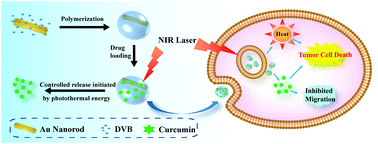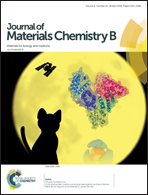Synthesis of Janus Au nanorods/polydivinylbenzene hybrid nanoparticles for chemo-photothermal therapy†
Abstract
Chemo-photothermal therapy has attracted tremendous attention due to its synergistic effect in killing cancer cells, making it one of the most efficient therapies. Although most of the applied core–shell hybrid nanoparticles (NPs) can perform such a function, the lowering of their thermal efficiency through polymer coating and limited drug loading capacity severely limit their performance. Janus NPs with exposed metal and a polymer/silica matrix show improved chemo- and photothermal-efficiency, but have a complicated synthesis, and their loading capacity for hydrophobic drugs still needs to be optimized. Herein, we report the facile synthesis of Janus NPs comprising Au nanorods (NRs) and a hydrophobic polydivinylbenzene (PDVB) matrix. The UV-vis extinction of the Janus NPs is in the near infrared region (the region used in medicine), which makes it an ideal candidate for photothermal therapy, and the hydrophobic PDVB component is a good anticancer drug (curcumin) carrier for chemotherapy. With this combination of chemo- and photothermal-effects, a significant decrease in cell viability, migration, and invasion was realised, making the material a promising biomedical candidate for the treatment of cancer.



 Please wait while we load your content...
Please wait while we load your content...